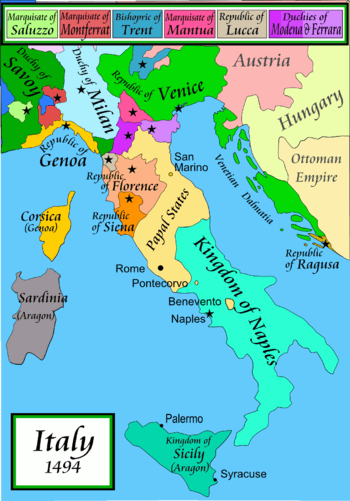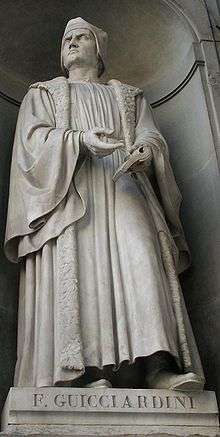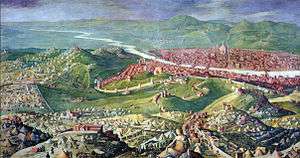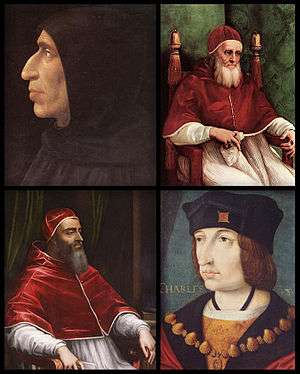Timeline of Niccolò Machiavelli

This timeline lists important events relevant to the life of the Italian diplomat, writer and political philosopher Niccolò di Bernardo dei Machiavelli (1469–1527).
Machiavelli was born in Florence in 1469 of an old citizen family. Little is known about his life until 1498, when he was appointed secretary and second chancellor to the Florentine Republic.[1] During his time of office his journeys included missions to Louis XII of France and to the Holy Roman Emperor Maximillian I; he was with Cesare Borgia in the Romagna; and after watching the second Papal election of 1503 he accompanied Pope Julius II on his first campaign of conquest. In 1507, as chancellor of the newly appointed Nove di Milizia (Nine of the Militia), he organised an infantry force which fought at the capture of Pisa in 1509.[1] Three years later it was defeated by the Holy League at Prato, the Medici returned to Florence, and Machiavelli was excluded from public life. After suffering imprisonment and torture, he retired to his farm near San Casciano, where he lived with his wife and six children and gave his time to study and writing. His works included The Prince; the Discourses on the First Decade of Livy; The Art of War and the comedy, Mandragola, a satire on seduction. In 1520, Cardinal Giulio de' Medici (later Pope Clement VII, 1523) secured him a commission to write a history of Florence, which he finished in 1525. After a brief return to public life, he died in 1527.[1]
Timeline
(Dates in square brackets are conjectural)

1469
- 3 May: Birth in Florence of Niccolò di Bernardo Machiavelli to Bernardo and Bartolomea (née de' Nelli).
1471
1480s
1481
- With his brother Totto, Niccolò begins the school of Paolo da Ronciglione.[2]
1484
- 26–29 August: After the death of Pope Sixtus IV, the papal conclave elects Cardinal Giovanni Battista Cybo as Pope Innocent VIII.
1490s
1491
- The Dominican priest Girolamo Savonarola begins to win influence in Florence.[2]
1492
- 9 April: Lorenzo de' Medici the de facto[3] ruler of the Florentine Republic dies, and his son Piero di Lorenzo (known as Piero the Unfortunate) becomes head of the Medici family.
- 11 August: Alexander VI elected pope.
1494
- The Italian Wars begins when Charles VIII of France invades Italy with a 25,000 men strong army.[4]
- November: Piero and the Medici are expelled from Florence, when French troops enter the city.
1498
- 23 May: Savonarola is executed for heresy, after being excommunicated by Pope Alexander VI in May 1497.
- June: Machiavelli is confirmed by the Great Council as second chancellor of the Republic.
- July: Machiavelli is elected secretary to the Ten of War (La Guerra dei Dieci), the body that manages Florence's military matters.[5]
- November: On behalf of the Ten of War he is sent on his first diplomatic mission to Piombino.
1499
- Report on the Pisan War, (Discorso della guerra di Pisa).
- Mission to Caterina Sforza-Riario, ruler of Imola and Forlì.
1500s
1500
- July: Machiavelli is sent on a six-month mission to King Louis XII of France. In France he also meets the Cardinal of Rouen Georges d'Amboise
1501
- Marries Marietta Corsini.
1502
- In the wake of the execution of Savonarola; Piero Soderini is elected gonfaloniere of the Florentine Republic for life by the Florentines, with the pretext of being given the mission to re-stabilise the republican institutions.[2]
1503
- Machiavelli publishes Description of the Manner in which Duke Valentio put Vitellozzo Vitelli, Oliverotto da Fermo, Lord Pagola and the Duke of Gravina to Death (Italian: Descrizione del modo tenuto dal Duca Valentino nell' ammazzare Vitellozzo Vitelli, Oliverotto da Fermo, il Signor Pagalo e il Duca di Gravina Orsini); Discourse about the Provision of Money (Discorso sopra la provisione del danaro), and On the method of dealing with the Rebellious Peoples of Val di Chiana (Del modo di trattare i popoli della Valdichiana ribellati).
- For Machiavelli's plan to assert Florentine authority over Pisa, which was in revolt against Florence from 1502–1509, Leonardo da Vinci is consulted on a scheme to divert the river Arno around Pisa to the sea at Livorno[6]
- April: Machiavelli is sent on mission to Pandolfo Petrucci, ruler of Siena.
- September: Election of Pope Pius III.[7]
- October: Machiavelli is sent on mission to the Papal court at Rome.[6]
- November: Election of Pope Julius II.[7]
1504
- January: Machiavelli travels on his second mission to the court of Louis XII.[6]
- July: Second mission to Pandolfo Petrucci.[6]
1506
- Discourse on Florentine Military Preparation (Italian: Discorso sopra il riformare lo stato di Firenze).[9]
- January: Recruits for the militia in the Mugello region, north of Florence.
- August–October: Machiavelli's second mission to the Papal Court follows Pope Julius II from Viterbo to Orvieto, Perugia, Urbino, Cesena, and Imola.[6]
1507
- December: Sent on mission to the court of the Holy Roman Emperor Maximillian I in the County of Tyrol.
1508
- Report on Germany (Italian: Rapporto delle cose dell' Alemagna).
1509
- Report on Germany and the Emperor (Discorso sopra le cose della Magna e sopra lo imperatore).
- The poem, The Second Decade (Decennale secondo); an update to Machiavelli's earlier work The First Decade (Decennale Primo) is published.
1510s

1510
1511
1512
- The Italian Wars continues, and after Spanish troops invade Florentine territory – and sack Prato – Florence surrenders, Piero Soderini is deposed and goes into exile as the House of Medici returns to power. (See War of the League of Cambrai).
[After April 1512]
[After April 1512 and before August 1513]
- November: Machiavelli is ousted from the Chancery and sentenced to a years confinement within Florentine territory.[10]
1513
- February: Machiavelli is tried for conspiracy, tortured and imprisoned.
- March–April: After his release Machiavelli retires to his farm at Sant'Andrea in Percussina, seven miles south of Florence.
- March: The papal conclave elects Giovanni de' Medici as, Pope Leo X.[7]
- July: Machiavelli drafts The Prince (Italian: Il Principe).[10]
[1514 or later]
1513
- Machiavelli enters a discussion group – interested in literature and politics – meeting at Orti Oricellari, in Florence. He starts writing Discourses on the First Decade of Titus Livy (Italian: Discorsi sopra la prima deca di Tito Livio), a commentary on the first ten books of Livy's History of Rome.
[1515–1520]
- Writes the novella Belfagor arcidiavolo[10] (published with Machiavelli's collected works in 1549).
Circa 1516
- Manuscript copies of The Prince begin to circulate in and beyond Florence.[10]
[1517 or 1518]
- Machiavelli's version of Apuleius' The Golden Ass (Italian: 'L'asino d'oro), a satirical poem of eight chapters, written in terza rima. The poem concerns the theme of metamorphosis, and contains autobiographical, grotesque, and allegorical episodes.
1518
- Writes a book on military organisation, The Art of War (Italian: Dell' Arte della guerra) and The Life of Castruccio Castracani of Lucca (La vita di Castruccio Castracani da Luca), as well as a Summary of Lucca's system of government (Sommario delle cosse della città di Lucca). He is commissioned to write the history of Florence by Cardinal Giulio de' Medici (later elected as Pope Clement VII, in the Papal conclave, 1523).[10]
[1519 or 1520]
- Discourse on the Florentine Affairs After the Death of Lorenzo (Discorso delle cose fiorentine dopo la morte di Lorenzo).
1520s

1521
- The Art of War is published.
1522
- Advice to Raffaello Girolami (Memoriale a Raffaello Girolami)
- Cardinal Adrian Florensz is elected Pope as Adrian VI.
1523
- Cardinal Giulio de' Medici is elected Pope as Clement VII.
[1524–1525]
1525
- Visits Rome to present his finished Florentine Histories (Italian:Istorie fiorentine) to Pope Clement. Machiavelli's satirical play The Mandrake (La Mandragola) is performed and acclaimed in Venice,[12] which he later visits on a mission to settle a trade dispute for the Wool Guild of Florence.[12]
1526
- Report on the Fortifications of Florence (Relazione di una visita fatta per fortificare Firenze).
1527
- May: The city of Rome is sacked by the Imperial Army of chiefly Germans and Spaniards under the Duke of Bourbon, during the War of the League of Cognac[12] (see the Italian Wars). The Medici are expelled from Florence, where the Republic adopts a new constitution.[13]
- 21 June: Machiavelli dies and is buried in the basilica of Santa Croce, Florence.
1530s
1531–1532
- Posthumous publication of The Prince, Discourses on Livy, and Florentine Histories.
(Dates in square brackets are conjectural)
See also
Notes
- 1 2 3 Grafton 2003, p. i.
- 1 2 3 Grafton 2003, p. ix.
- ↑ Kent 2006
- ↑ Ritchie & Konstam Historical Atlas of the Renaissance, p. 64
- ↑ "Niccoló Machiavelli". Great Minds Machiavelli biography. Institute for the Study of Western Civilization. Retrieved 29 September 2011.
- 1 2 3 4 5 6 7 Grafton 2003, p. x.
- 1 2 3 Creighton 1887
- ↑ Wootton Selected Political Writings, p. 37
- ↑ Germino, Machiavelli to Marx, p. 24
- 1 2 3 4 5 6 7 8 Grafton 2003, p. xi.
- ↑ Falco (Ed.), Feminist interpretations of Niccolò Machiavelli, p. 334
- 1 2 3 Grafton 2003, p. xii.
- ↑ Hibbert p. 181
References
- Creighton, Mandell (1887). A History of the Papacy During the Period of the Reformation Vol. IV: The Italian Princes, 1464—1518. London: Longmans, Green, and Co.
- Germino, Dante (1972). Machiavelli to Marx : Modern Western Political Thought. Chicago: The University of Chicago Press. ISBN 0-226-28850-1.
- Falco, Maria J. (Editor) (2004). Feminist Interpretations of Niccolò Machiavelli. Penn State Press. ISBN 0-271-02389-9.
- Grafton, Anthony (2003). The Prince; Introduction by Anthony Grafton (25 ed.). Penguin Classics. ISBN 978-0-14-044915-0.
- Hibbert, Christopher (1975). The House of Medici: Its Rise and Fall. Morrow. ISBN 0-688-00339-7.
- Kent, F.W. (2006). Lorenzo De' Medici and the Art of Magnificence. USA: Johns Hopkins University Press. ISBN 0-8018-8627-9.
- Konstam, Angus; Ritchie, Robert (2003). Historical Atlas of the Renaissance. New York: Facts on File (Checkmark Books). ISBN 0-8160-5731-1.
- Wootton, David (1994). Selected Political Writings of Niccolò Machiavelli. Hackett Publishing. ISBN 0-87220-247-X.

